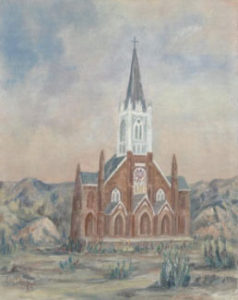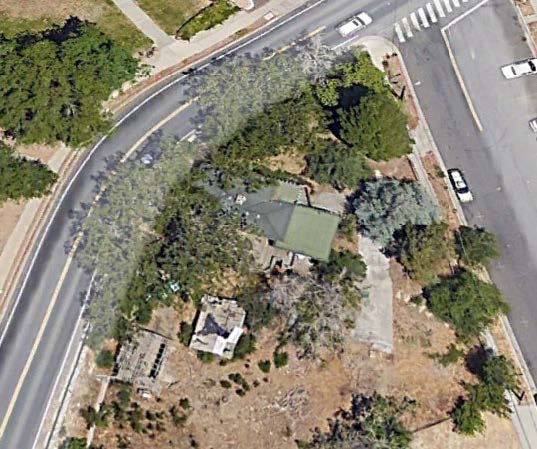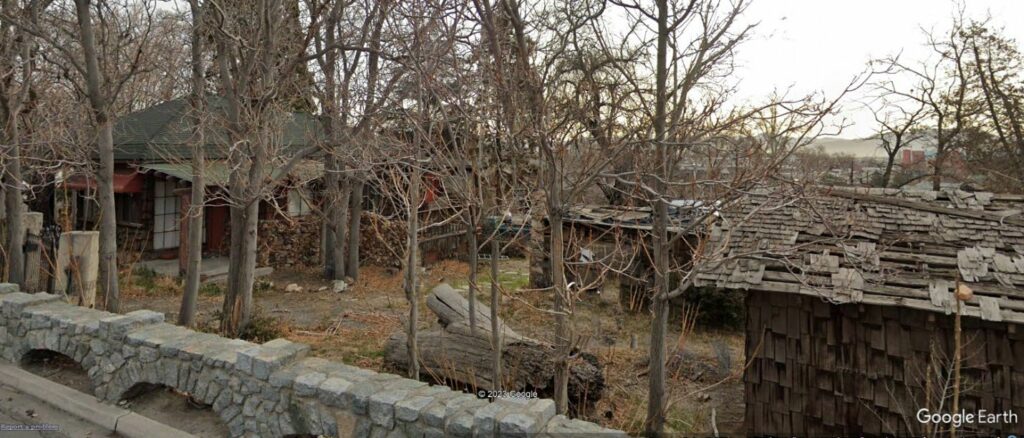DOROTHY MARTIN DINSMORE
The information below has been compiled from a variety of sources. If the reader has access to information that can be documented and that will correct or add to this woman’s biographical information, please contact the Nevada Women’s History Project.
At A Glance:
Born: December 27, 1876, Foxcroft, Maine
Died: December 7, 1963, Alameda, California
Maiden Name: Dorothy Martin
Race/Nationality/Ethnic Background: Caucasian
Marrried: Sanford Crosby Dinsmore (August 7, 1906)
Children: None
Primary City and County of Residence and Work:
Reno, Washoe County
Major Fields of Work: Citizen Activist and Artist
Other Role Identities: University of Nevada faculty wife
Biography
Unrecognized Founding Member of the Nevada Art Gallery (now Nevada Museum of Art)
Dorothy Martin Dinsmore was born in Foxcroft, Maine in 1876, the daughter of John B. and Ann Welch Martin. The role this lady played in the genesis of the current Nevada Museum of Art/Wiegand Art Gallery in Reno, Nevada makes an interesting story.
After completing high school Dorothy found work in a Foxcroft dry goods store, and at some point met a young University of Maine college student by the name of Sanford Dinsmore. Upon his graduation, Sanford was hired by the University of Nevada in August of 1905 as a chemist in the University Experimental Station. The following year he returned to Maine, where he married Dorothy on August 7, 1906, and promptly brought his young bride back to Nevada.
Reno was growing by leaps and bounds, and in 1907 the young couple purchased the first three of five parcels in a newly opened housing tract located on University Terrace two blocks from the university, becoming the second family to build on the street. Landscaping was important to both, and their home became a “go to” venue for entertaining university faculty, as well as Dorothy’s club members and friends. There were trees, numerous flowers and shrubs and a pond filled from the Orr irrigation ditch that bordered their land. As noted in a 1932 Reno Evening Gazette article:
“About the most beautiful place in Reno, in our humble opinion is the home of Professor S.C. Dinsmore at West Street and University Terrace. A wide stream of water winds gracefully through the spacious yard, and trees, grass and shrubbery are planted in a most effective manner. A bridge spans the stream. Whenever we drive by the Dinsmore place, we slow down to admire it. Many another home site has an irrigation canal winding through it, but few have been able to make such an asset of a canal as Dinsmore.”
Dorothy later had a small shed remade into an art studio adjacent to the house.

Dorothy wasted no time in entering the Reno social scene. By late 1907 the couple was chaperoning university fraternity functions. She obtained membership in the Reno branch of National League of American Pen Women, where she was active in poetry and art and held leadership positions in the organization. She sang in the Congregational Church chorus, joined several bridge clubs, and with husband Sanford, helped establish a dance club with their cadre of friends. She joined the Baptist Dorcas Circle Women’s Auxiliary, the Twentieth Century Club, and in 1931, was voted a member of the exclusive Latimer Art Club.
Art and literary activities appear to be Dorothy’s passions. It is unknown whether she was active in women’s suffrage, though many of the organizations that she belonged to were involved in women’s suffrage. Local news articles give evidence of her fondness for the spoken word and her love of gardening. Her paintings speak to her artistic talent and her love of Nevada’s vast landscapes.
Dorothy was obviously a community activist who was most generous with her time, one who volunteered in various capacities to make Reno richer in the arts and, through her religious affiliations, helped Reno’s underprivileged.
What both Dorothy and Sanford were most passionate about was an idea championed by Sanford’s co-worker, University Professor Dr. James Church, and Reno businessman and art patron, Charles F. Cutts. They proposed to build a state art museum that would be located on land directly west of the Dinsmore University Terrace property along the Orr Irrigation Ditch. It was to be called the Nevada Art Gallery. The organization was incorporated in early 1931 and would be primarily a University/Nevada Art Gallery venture, with land donation, financial support, and active
involvement by the Latimer Art Club.
The couple felt so strongly about this new venture that they donated their University Terrace home and adjoining land parcels to the Nevada Art Gallery to be used as “open space” next to the “Gallery Gardens” that were to serve as the gallery/museum landscaped area. The Dinsmore vacant land parcels were to be an extension to the Gallery Gardens and the home would come later as a “legacy” donation.
Charles Cutts died in 1949 and willed his home on Ralston Street and art collection to the Nevada Art Gallery. His house was donated to be used as the temporary home of the Nevada Art Gallery until the main University Terrace Gallery could be financed and built. Dorothy was named a Director at Large of the Charles F. Cutts Art Foundation in 1950, charged with reviewing the collection and facilitating the transfer of the Cutts art collection to the Nevada Art Gallery Inc., thus forming the nucleus of its art collection. Dorothy, with co-Latimer Art Club member, Minerva Pierce, was instrumental in the transition of this collection. Dorothy became a member of Nevada Art Gallery Board in 1950 and she and fellow Latimers were instrumental in overseeing the transformation of the Cutts home into an art gallery.
Although Sanford died in 1944, Dorothy continued her civic activities. At age 74, she was made an honorary member of the Latimer Art Club in 1950, and continued to serve on the Nevada Art Gallery Board until 1955, when she resigned. The Nevada Art Gallery transitioned, with several intervening name changes and locations, into the current Nevada Museum of Art, soon after.
Childless, at the age of 80, with no close relatives nearby, Dorothy moved to Oakland in 1956 to live near a friend. She died there in 1963. A short but nice obituary was written for the Reno newspapers (probably by a Latimer member), crediting her with playing an important part in the formation of the Nevada Art Gallery. Then, with the passage of time, her contributions were completely forgotten in Reno’s art history.
Now only her stone-faced house, her studio, an aged shed once again, and several large pine trees on the corner of West Street and University Terrace give evidence that she ever lived in Reno. Although she was a member of many of Reno’s social organizations, no known photograph of her exists. Fortunately, some of her paintings do exist in private collections. I treasure mine.


Dorothy’s most important legacy is the unheralded, but now rediscovered role she played in the current Nevada Museum of Art’s origins. She should be remembered as one who moved to our state by choice, and through her many contributions to her community, became a true Nevada woman.
Researched and written by Patti Bernard. Published on nevadawomen.org December, 2017.
Sources of Information:
- A Public Spirited Enterprise.” Nevada State Journal (Reno), April 26, 1931, p4:1.
- “Art Gallery Here Will Be Open Today.” Nevada State Journal (Reno), December 17, 1950, p15:5.
- “Baptist Auxiliary Has Luncheon Tuesday.” Nevada State Journal (Reno), May 4, 1950, p5:4.
- “Congregational Church.” Daily Nevada State Journal (Reno), March 31, 1907, p1:7.
- “Cutts Art Gallery Scheduled to Open.” Reno Evening Gazette, October 12, 1950, p28:1.
- “Cutts’ Home Will Open As Art Museum.” Nevada State Journal (Reno), July 26, 1950, p8:3.
- “Friends Form Dancing Class.” Reno Evening Gazette, March 20, 1915, p1:4.
- “Great Activity in Real Estate Circles.” Reno Evening Gazette, October 28, 1907, p5:2.
- “Guests Enjoy Faculty Picnic.” Nevada State Journal (Reno), September 13, 1932, p5:1.
- “In A Social Way.” Nevada State Journal (Reno), November 2, 1907, p4:3.
- Leaf, Earl. “Loose Leaf Column.” Nevada State Journal (Reno), July 24, 1932, p1:1.
- “Mrs. Dinsmore is Hostess.” Reno Evening Gazette, October 30, 1915, p8:7.
- “Mrs. S. Dinsmore Will Be the Hostess.” Nevada State Journal (Reno), May 19, 1912, p10:4.
- Nevada Art Gallery. Board of Directors Minutes, July 18, 1941. Dorothy Dinsmore File, Nevada Women’s History Project Collection, Nevada State Historical Society, Reno, Nevada.
- “Nevada Art Gallery To Open Sunday Free to Visitors.” Reno Evening Gazette, November 10, 1950, p9:2.
- “New Fraternity House To Supplant Landmark.” Reno Evening Gazette, January 10, 1955, p11:3.
- “Pen Women Show Work of Artists.” Reno Evening Gazette, November 28, 1949, p8:3.
- “Prof. S.C. Dinsmore Claims Miss Dorothy B. Martin of Foxcroft, Maine, as Bride.” Reno Evening Gazette, August 20, 1906, p5:1.
- “Resident Traps Burglar; Holds Shotgun on Him.” Nevada State Journal (Reno), June 8, 1954, p10:3.
- Rowley, Gladys. “Reno, Revue.” Nevada State Journal (Reno), February 27, 1940, p4:3.
- “Sanford C. Dinsmore Dies At Home Today.” Reno Evening Gazette, March 8, 1944, p12:1.
- “Warren Brandon Presents Sunday in Nevada in Nevada Art Gallery.” Nevada State Journal (Reno), November 9, 1961, p5:2.

